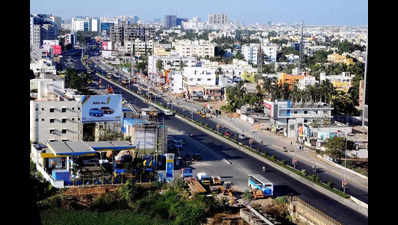OMR a mess, and we are to blame too | Chennai News – The Times of India

Chennai: Old Mahabalipuram Road, the famed IT corridor that reshaped Chennai’s skyline, is facing an infrastructure crisis; a classic case of rapid urbanization outpacing the development of basic amenities. A ton of money goes to infrastructure costs and taxes, yet a joint inspection of 2,513 buildings by GCC, Metrowater and CMDA exposed serious inadequacies, raising concerns that the stretch could turn into an urban disaster. And buildings flouting govt norms add to the problem.
Most issues are with water and sewage connections, roads, stormwater drains, and solid waste management. “Beyond SRP Tools, there is no water or sewage connection. With more than 90 new projects, both residential and commercial in the pipeline, we’re looking at a perfect storm of infrastructure inadequacies,” said a developer.
Last year, chief secretary N Muruganandam ordered an inspection after OMR experienced severe flooding even during minimal rainfall. In was conducted in Dec across zones 13, 14, and 15. The most glaring issue was the widespread absence of rainwater harvesting (RWH). Only 35% of the buildings have proper systems in place, while 56% of buildings have poorly maintained ones. “Many high-rises follow the norms; the defaulters are mid-rise buildings,” said a CMDA official. While CMDA guidelines mandate RWH installations and tie them to completion certificates, lax enforcement has led to water stagnation and flooding during heavy rains.
The sewage situation is equally alarming. “We took up 800 cases for review. Out of this, 54% relied on septic tanks, while 45% used sewage treatment plants (STPs). Among developments approved by CMDA with more than 50 dwelling units, 80% complied with the requirement to install STPs. However, smaller developments, with 16 to 50 units, predominantly used septic tanks,” said a CMDA official. A Metrowater official said septic tanks were decanted regularly through lorries.
It isn’t just a compliance issue but a looming environmental disaster, urban planning experts warn. “Improper septic tanks or malfunctioning STPs can lead to groundwater contamination and public health issues. Regular monitoring and certification by Metrowater is needed. They should be made responsible for pollution in the area,” said former CMDA chief planner N V Rakhunath.
He said the situation is worsened by the disconnect between development approvals and infrastructure readiness.
“Builders need to implement RWH structures on their own, and residents have to demand that such structures be in place. Enforcement will then become easier,” said coordinator of Save Water and Recharge Aquifers Network (SWARAN) Ram Shankar.
The lack of enforcement of existing regulations and poor coordination between various authorities remains a major concern. “Though joint inspections are conducted, there seems to be no cohesive plan to address the identified issues. This fragmentation threatens to undermine any meaningful solution to OMR’s infrastructure challenges,” said an urban planner.
Meanwhile, a senior official said show cause notices would be provided to buildings flouting norms, while a Metrowater official said all of OMR would have underground sewage scheme by end of 2026. “Some projects such as Okkiyam Thoraipakkam, Kottivakkam, Palavakkam, Neelangarai, Uthandi and Semmenchery will get over by 2026. For rest of the area, services are being provided,” the Metrowater official said.















